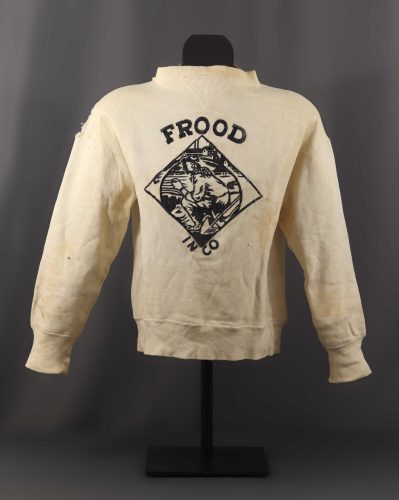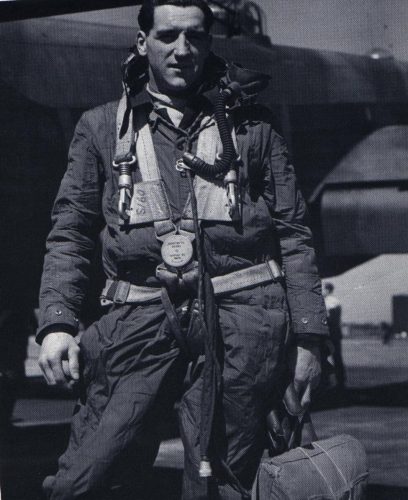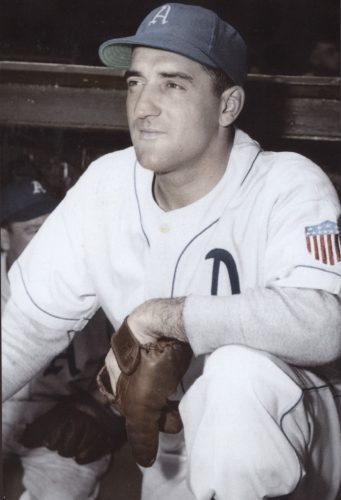Phil Marchildon

Born in Penetanguishene, Ontario in 1913, Phil Marchildon is a Canadian Baseball Hall of Famer, and was no stranger to the game of baseball played through the Second World War. After dropping out of college in Toronto in 1935, Marchildon went to work in Sudbury’s nickel mines. Having played baseball since high school, he was able to take up the sport again, playing senior ball for his company’s team, International Nickel of the Nickel Belt League. He was so successful with the company team, pitching 275 strikeouts in only 25 games, that in 1938 at the age of 24 he earned himself a tryout with the Toronto Maple Leafs baseball team. There he would impress the coaches, and signed with the team for the 1939 season, having only played baseball for around ten years by that point.
Finding his footing in the 1939 and 1940 seasons while playing for the Cornwall Can-Am League affiliate of the Toronto Maple Leafs baseball club, Marchildon earned a late-season call-up in 1940 to the Major League Philadelphia Athletics, managed by Connie Mack. Although he lost his only two games of that season, he impressed, and would later join the club’s starting rotation in the following two seasons. Unfortunately, as a dominant pitcher with poor defence behind him, Marchildon’s numbers at no point reflected his talent. Following the 1942 season, Marchildon would join the war machine.
Marchildon joined the all-volunteer Royal Canadian Air Force (RCAF), training in Manitoba as an aerial gunner, then in Trenton, Ontario, where he pitched for the Trenton Air Force Team. He graduated as a gunner in mid-1943, and was initially stationed in Halifax, Nova Scotia, playing ball for the Halifax Air Force team until his journey overseas began in August of that same year.
Although Marchildon would only play the occasional game of recreational baseball while awaiting his missions in the UK, Marchildon lined up for the DeHavilland Comets, a local manufacturers’ team which his brother-in-law, Adam MacKenzie played for. Marchildon’s skill was a surprise to the opposing Americans, and it was noted that many batters could barely flinch as the ball was blown past them. Only after the several helpless batters watched the three strikes fly by them would MacKenzie reveal to the opposition that Marchildon was in fact, a professional pitcher.
As a tail gunner on an RCAF Halifax Bomber in the Air Force, Marchildon, like every Royal Canadian Air Force member, was required to fly 30 missions in the War to fulfil his military service obligations. On August 17, 1944, he flew mission number 26 alongside six crew members. With only four operations remaining, his 26th should have been a simple mine-laying mission (dropping naval explosive mines on parachutes to drift into enemy shipping lanes), but over the Baltic Sea, a German fighter plane attacked Marchildon’s craft. In the chaos, only Marchildon and his navigator managed to escape the crash with their lives. Stranded at sea, Marchildon and his navigator were fortunate enough to be rescued by a Danish fishing boat, but they were handed over to German authorities and sent to the Stalag-Luft III, a prisoner-of-war camp in German-occupied territory which is now a part of Poland.
While Marchildon would spend the next 9 months suffering alongside thousands of his fellow Allied soldiers, he quickly joined roughly 350 other POWs in the camp’s softball league. Playing as an outfielder, Marchildon hit with plenty of power, and his team would eventually win the camp league’s championship.
On May 2, 1945, Marchildon was freed after the camp was captured by English-American forces. He had lost plenty of weight and strength, and faced an ongoing battle with Post-Traumatic Stress Disorder as a result of his experiences. Marchildon did talk openly about the horrors he witnessed in the camp and the impact this experience had on him, all of which made him hesitant to return to baseball, but he was eventually convinced. With a shakier voice and visibly smaller, he returned to his Philadelphia Athletics on August 29th of 1945, at which time he threw five innings, allowing only two hits. He pitched successfully until 1947, when an arm injury slowed his career, forcing him to retire in 1950. Following his baseball career, he returned to Ontario, working mechanical and factory jobs until retiring at age 65 in 1978. Phil Marchildon was ultimately inducted into the Canadian Baseball Hall of Fame in 1983 as a member of the inaugural class alongside John Ducey, James ‘Tip’ O’Neill, George Selkirk, Lester B. Pearson, and Frank Shaughnessy. Phil Marchildon passed away at age 83 in 1997.















